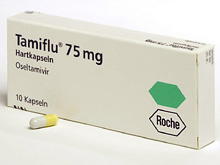Stockpiling Tamiflu may be easiest part
Stockpiling the influenza drug Tamiflu may be the easy part. Quickly shipping pills on trucks and planes to remote, impoverished areas if bird flu becomes a pandemic strain could be much more tricky, a drug company official said Thursday.

David Reddy of Swiss-based Roche Holding AG, which makes the influenza-fighting drug Tamiflu, said the logistics become more difficult once the illness breaks out.
"In shipping it in, we have to consider things like one or two 747s to get to the site of outbreak," Reddy said. "I think in many ways, the establishment of a stockpile is the easy part."
More research also is needed on the drug to determine its optimal dosage and study how people develop resistance, said Dr. Frederick G. Hayden, a University of Virginia virus expert who spoke at a two-day bird flu conference in Singapore organized by The Lancet medical journal.
Hayden is collaborating on a two-year study involving 400 participants in Vietnam, Thailand and Indonesia, expected to begin this year. It is the first controlled clinical study looking at the effectiveness of Tamiflu given to people infected with the bird flu virus.
It will look at how patients respond to standard doses of Tamiflu currently recommended for annual seasonal flu, as well as higher doses. The study will involve both adults and children.
Health experts have touted the antiviral Tamiflu as the most effective medicine available to fight bird flu, and countries worldwide have been racing to stockpile it in case the virus mutates into a form easily spread among people. But little is known about how much Tamiflu should be given to a person infected with the H5N1 bird flu virus. Dosage recommendations are currently not even available for children under 1 year of age.
Hayden said the World Health Organization is expected to announce revised dosing recommendations for Tamiflu this week.
Research has also shown that the drug is most effective when given early, ideally within 48 hours of infection.
Reddy said 10 people infected with bird flu in Turkey were given the drug. Four died after taking it 8.5 days after being infected, while the other six survived after beginning treatment 3.5 days after infection.
Hayden said research models suggest that if a drug stockpile large enough to cover 20 percent of the population had been available during the 1918 Spanish flu pandemic, the number of deaths could have been cut in half. The virus killed up to 40 million people worldwide.
Using antiviral drugs as preventive medicine during a pandemic, instead of just as treatment, could prove difficult because a much larger stockpile would be needed, Hayden said.
If 1,000 people, such as health care workers, were put on preventive antiviral drugs for an eight-week period during a pandemic, they would need 56,000 doses. However, if they were instead simply monitored for symptoms and treated once infected, about 35 percent would become ill and the amount of medicine needed would be 3,500 doses, he said, reports the AP.
I.L.
Subscribe to Pravda.Ru Telegram channel, Facebook, RSS!




